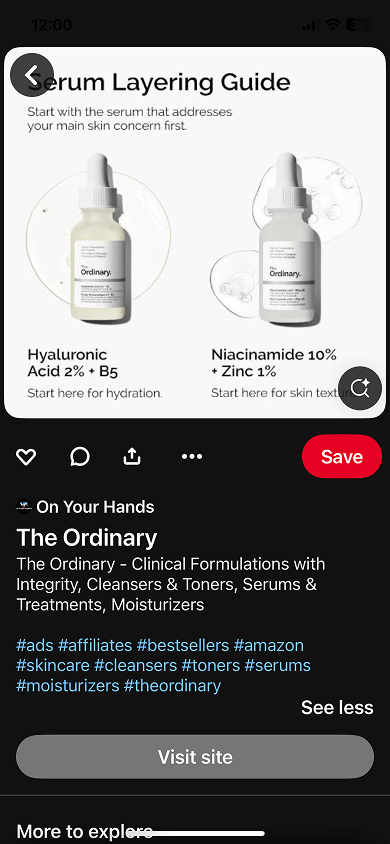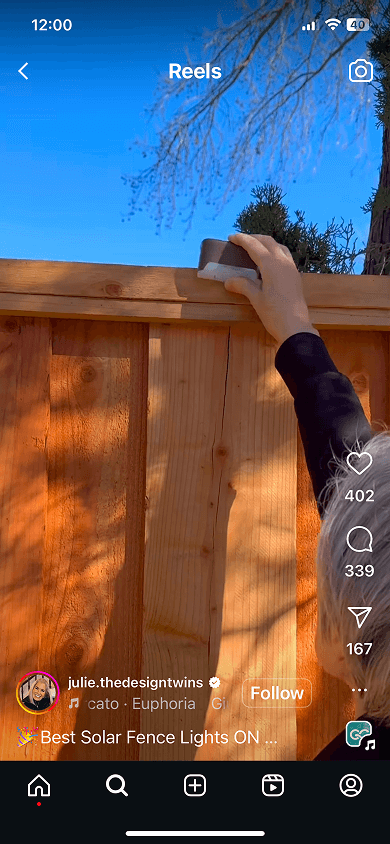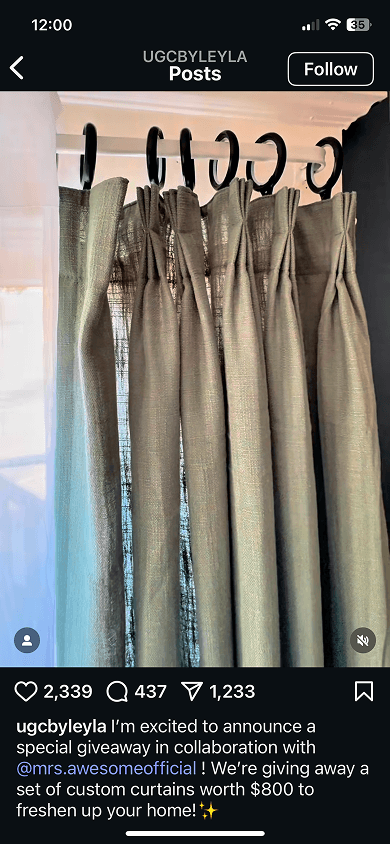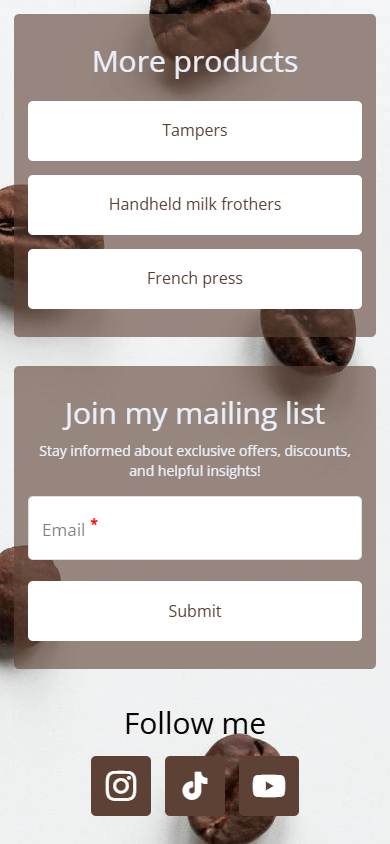Using social media in affiliate marketing: best tips for growth

- Define your audience
- Enhance your profile with essential information
- Include a link to your link in bio page
- Type a description of your services
- Create regular and authentic content
- Product or service reviews
- Product or service comparison
- Myth-busting content
- Guides on how to use the product
- User-generated content
- Engage with your audience
- Run contests and giveaways
- Run polls
- Ask questions
- Collect emails for future email marketing
- The bottom line
Identifying the audience that follows you is the first step in social media marketing for affiliates. Once you identify their key characteristics, you can create content that resonates with them and boosts engagement on your account.
When analyzing your audience, consider the following characteristics:
- Age: Different age groups prefer different types of content and communication styles. For example, younger audiences tend to enjoy short, dynamic videos, while older generations might prefer expert opinions and in-depth text posts.
- Gender: Although gender-based content preferences are becoming less pronounced, some differences remain. Women often gravitate toward aesthetic visuals, soft tones, and self-care messages, whereas men may respond better to data-driven analysis and in-depth reviews.
- Purchasing power: If your audience tends to buy high-end products and services, highlight exclusivity and premium quality. If they buy budget-friendly options, try to emphasize affordability, value for money, discounts, and special offers.
These are just a few characteristics to consider. Think about other common traits your followers might share and analyze them to refine your content strategy.
If you always keep in mind the specific needs and interests of your target audience, success in your marketing strategy via Instagram, Pinterest, or other social media is guaranteed!
Whether you're promoting Amazon products on social media or those from other brands, your profile won’t be able to assist you in boosting your income unless you fill it with all the critically important details. In this section, we’ll guide you on what it would be helpful for you to include in your social media profile description.
Affiliate marketers often lack space in their bio or About section to add links to all the promoted products. TikTok and Facebook, for example, allow only one link. While Instagram lets users add up to five links, this may still not be enough if you’re promoting many products along with sale items.
To solve this issue, use a link in bio page. A link in bio page is a webpage where you can gather all the information about the products you are promoting. The link to this page can be added to your profile description. So, instead of multiple product links, you’ll have a single link to the page with all the information and links.
Here’s an example of a link in bio page for affiliate marketing you could have. This page promotes Amazon affiliate links to coffee products and coffee equipment.


The entire page is available here.
This link in bio page for promoting affiliate links on social media was built using Taplink. You can also use Taplink, as it provides the following benefits:
- Prompt creation: You won’t need much time to create a link in bio page. It takes 15 minutes to create a page like the one above.
- Ready-to-use templates: Taplink’s library offers more than 100 templates that you can change as you please.
- Developed for phones: Taplink pages are designed for mobile devices, ensuring instant loading and a perfect display on all smartphones.
Creating a Taplink page takes just four steps:
- Sign up for Taplink.
- Select the most appropriate template. Or use the template that we used for the page above.
- Add your content to your link in bio page.
- Publish the page.
And most importantly, add your Taplink page link to the bio or About section of all social media platforms where you promote your products.
Now that you know how to register on Taplink, you can rest assured that you’re halfway to success!
You can also use this to put Amazon products to your Stories or products from another brand. This allows you to work around Instagram’s one-link limit in Stories and promote multiple products at once.
Besides the link, the bio also allows you to add text, so don’t overlook this feature. It can determine whether a user engages with your content and buys your products or services.
Your bio should be short but informative. As an affiliate marketer, you could include the following details:
- Your niche: Mention the industry you are in. It can be a specific product category, like coffee and coffee equipment. Or it can be a broader topic, like healthy living or finance.
- Value for the audience: Describe how users benefit from your content. Maybe you help them find top-quality products or explain difficult topics in a simple way.
- Call to action: Clearly state what you want your followers to do. This could be buying a product, booking a service, or just learning more. Let them know they can do it through the link in your bio, which takes them to the page you created with Taplink.
Check out our social media bio for affiliate marketers in copy-paste style.
Many brands also require affiliates to specify that they are affiliate marketers. Rather than adding this information to every promotion post, you can include it in your social media bio.
It’s not so hard to guess that content is the core of affiliate marketing in social media. That’s why it should be helpful, interesting, and convincing.
Customers will be much more likely to buy a particular product or service by following your link if they actually trust you.
So, if you wonder how you can build a successful social media marketing affiliate business, the first thing you should do is catch your target audience with inspiring content.
Detailed and honest reviews of products or services are a great strategy for social media marketing for affiliates because they showcase your expertise. In turn, expertise helps build trust with your audience.
The most powerful way to create product reviews is through video content, such as YouTube reviews. However, you can also showcase products through photos, using captions to provide detailed information. This technique helps you promote your affiliate links on Pinterest or Instagram, for example.
Always stay honest and objective when reviewing products. Cover both strengths and weaknesses to ensure transparency and maintain credibility with your audience.
Leverage personal experience. Talk about how you’ve used the product or service and support your insights with proof like photos or videos.
Don't forget to tailor your content to your audience’s interests. Explain how a particular product addresses their challenges and makes things easier for them.
Comparing products and services is an excellent social media affiliate marketing strategy that helps people make informed purchasing decisions.
With so many products and services available, choosing the right one can be challenging. By comparing your product with others, you’ll help your followers understand what sets your product apart, what needs it fulfills, and what problems it can solve.
Like with product reviews, when making comparisons, be transparent and honest with your followers. Don’t overly praise your product while putting others down. This will come off as unnatural and seem like obvious advertising.
Instead, openly discuss both the strengths and weaknesses of your product. After all, even weaknesses can be turned into strengths in some cases.
When comparing products, use various visuals. Add text to videos or photos to emphasize key points. Use tables and charts to clearly show the differences between the products, making the information more accessible.
Here’s an example of a Pinterest post by an affiliate marketer comparing two products. For more details, the marketer offers to follow the link below.

Although it may sound strange, many customers often doubt the choices they make every day. This is often because of old stereotypes and marketing myths. You can debunk these false beliefs using facts. This will help you spark interest in the products you’re promoting.
Debunking myths also helps overcome objections from potential buyers. For example, you could be involved in fitness affiliate marketing via Pinterest or Instagram and your female followers could believe that lifting heavy weights will make them bulky. This will prevent them from purchasing certain fitness products from you. By debunking this myth, you remove the hurdle and encourage women to purchase the products you’re promoting.
When picking a myth to discuss, choose the most popular ones that relate to your area of expertise. This will directly influence your sales count.
When debunking myths, rely on official and scientific information. Include experimental data, links to scientific articles, and simple real-life examples. Scientific facts are the best way to prove something.
Simple videos or photos of how you use the product you’re promoting are another way to promote your affiliate links on social media. Many products, especially new ones to the market, can seem complicated for people. So, if followers know how to use them, it will be easier for them to make the decision to buy.
Product usage guides don’t necessarily need to be about complicated products. Even if you’re promoting simple items like coffee beans, show people how you brew coffee with them, and talk about the rich flavor and aroma of the coffee.
If your product is comprehensive, you can break your how-to content into several parts. For example, if we were promoting a Taplink subscription, we could make one video showing how to create a digital product on a Taplink link in bio page. And another video showing how to add and adjust a countdown timer.
When demonstrating how the product works, focus on how it helps solve people’s problems. Give examples of common life scenarios that many face, and explain how your product can help in those situations.
This is how an affiliate marketer promotes outdoor lights on Instagram, explaining how to install and use them.

User-generated content (UGC) is content created by consumers or users rather than brands. It includes photos or videos of customers with your product, screenshots of their reviews, and so on.
By incorporating UGC into your affiliate marketing social media strategy, you increase trust as not only you but also your customers speak highly of the products you promote.
To get UGC from customers, encourage them to create it. For instance, ask a customer to take a picture of them with your product and share it on their profile. Alternatively, ask them to leave a review about you. Repost customer photos on your social media or share screenshots of their reviews.
Make sure to ask customers for permission before publishing their content on your social media. This will help prevent any copyright issues and will solidify your reputation as a trustworthy affiliate marketer.
Posting content alone can’t be a guarantee of success. That’s why it makes sense to interact with followers to keep them focused on your account. Below, we’ll look at four methods that will help you boost engagement and promote your affiliate products on Instagram, YouTube, and other social media platforms.
If you want to better promote affiliate links on social media, run contests and challenges among your followers. Contests encourage likes, comments, shares, and follows as people participate. This boosts your visibility because social media algorithms tend to promote accounts and content with high engagement. That’s why contests are a great way to promote your affiliate products on social media.
To host a contest or giveaway, set clear participation rules for your audience. Here are some actions you might require from participants:
- Follow your account.
- Like the contest post or share it.
- Comment on the contest post.
Avoid overly complex rules — simplicity encourages more people to join.
As for prizes, you can offer a broad spectrum of rewards: discounts, gift tokens, free products, etc. The key is to ensure the prize is valuable to your followers.
For example, here’s how an affiliate marketer runs a giveaway on Instagram. The prize for this giveaway is curtains that the affiliate is promoting.

Many people deeply appreciate the fact that their opinion is considered valuable. That’s why you can resort to using polls. Polls drive interaction on your account. This increases your visibility, which helps you better promote affiliate links on social media.
Polls are also a great way to understand your audience’s preferences and pain points. This insight allows you to tailor your content to their interests and present products and services in a more strategic way.
You can conduct polls on various platforms that support them, including Instagram Stories, Telegram, Facebook, TikTok, or YouTube.
Keep your poll short and easy to understand. Offer 2 to 4 response options so that followers can read it quickly. The easiest way is to simply provide “yes” and “no” choices.
If your poll is related to the products or services you promote, consider offering a reward for participation. For instance, if you ask whether your followers have tried Liberica coffee, you can provide them with a discount on those coffee beans via your affiliate link.
In addition to polls, you can also ask questions, encouraging followers to use the comments to respond. This approach allows you to receive more in-depth and thoughtful responses rather than ready-made answers in polls.
By engaging your audience with questions, you show that their opinions and stories matter to you. This fosters a sense of community, making followers feel valued and more connected to you.
Your questions can be simple, like “Do you prefer coffee or tea?” But they can also be more open-ended and thought-provoking, such as “What’s your biggest struggle with staying productive?”
A great way to encourage responses is by sharing your own experience first. For example, talk about what challenges your productivity and how you deal with it. Then invite your audience to share their own insights.
Make sure to read and respond to the comments regularly. You can simply like the responses. Or you can reply to them and engage in discussion. This way you’ll show that you value your audience’s opinion which will help build stronger trust.
Email marketing is one of the most effective tools for promoting affiliate products. It allows you to communicate with people directly, fostering stronger relationships with them.
Email marketing also leads to higher conversions since people who sign up for your emails are genuinely interested in your content and niche.
There are many types of content you can send to your subscribers. Here are some examples:
- Special offers & discounts: Share discount codes with subscribers, notify them about limited-time offers, and exclusive promotions available through your affiliate partnerships.
- Announcement of product launches: Inform your audience about new products or services that you’ve started promoting.
- Educational content: To avoid overwhelming subscribers with promotional messages, send tutorials, informational articles, and industry news relevant to your niche.
One common challenge in email marketing is that people are often reluctant to share their email addresses. To overcome this, you need a compelling incentive — this is where lead magnets help.
A lead magnet is a free product you offer in exchange for people’s email addresses. As a lead magnet, choose something valuable for your audience. It could be as a guide, checklist, or discount code for your promoted products.
To simplify the email collection, create an opt-in form on your Taplink link in bio page, which we talked about earlier. Taplink also allows you to set up automatic lead magnet delivery once a subscriber submits their email.
For example, on our affiliate marketing link in bio page created for this article, the opt-in form looks this way. You can create a similar one using Taplink.

We do hope that our tips for affiliate marketing promotion on social media will help you. It’s time to recap everything we’ve discussed.
To effectively promote affiliate links on Instagram, Pinterest, YouTube, and other social media platforms, use the following strategies:
- Analyze your audience: Define their demographics, interests, and purchasing behavior to create content that resonates with them.
- Fill out your bio: Add a link to your Taplink link in bio page featuring links to your products and services, their images and descriptions, and other essential details for your followers. Also, make sure your bio clearly explains who you are and what you offer.
- Diversify your content: Mix your content with product reviews, comparisons with other products, usage tutorials, myth-busting, and user-generated content.
- Interact with your followers: Host contests and giveaways, use polls, and ask thought-provoking questions. Also, collect followers’ email addresses to provide personalized information to each.
Promoting affiliate products on social media may seem challenging, but following these recommendations can make the process much easier.